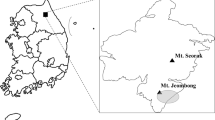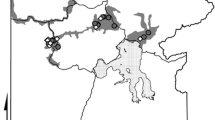Abstract
The objectives of the survey were to protect and increase the European bison (wisent) population size and to study its economically important traits under the environmental conditions of their habitats and ranges shifted with advancing northward as far as the northern European part of Russia. The subject of the survey was the purebred European bison in the Vologda oblast. High-level resistance to helminthes, flexibility and adaptability under new habitat conditions, and gaining the required phenotypic traits in the European bison were ascertained. The liveweight, the height at withers, the width of a hoof horn of a fore limb, and the hind-limb hoof horn width in the free-ranging wild oxen comprised 900 kg, 180 cm, 100 mm, and 80 mm, respectively. Thickness of hide in the forehead comprised 13 mm. Hide thicknesses of the neck and nape made up 9 mm each. The metatarsal, tarsal, carpal, and metacarpal areas comprised 7 mm thickness each. The hide at abdomen and sides of the animal was 6 mm in thickness. Therefore, the European bison hide parts are thicker than that in large cattle by 2–4 mm. In addition, rich ruminal microflora is typical for the European bison, since the bison, compared to farm animals, consume a wider variety of feeds. In Vologda oblast, the bison consume more than 100 plant species. Woody-stem fodder is used throughout the year. In the summer and winter seasons, it comprises up to 5 and 70% of their ration, respectively. Natural dietary dry-matter digestibility comprises 53–67.5%. The plant-fiber digestion level reaches 69%. The European bison meat-protein content is twofold greater than the value for the same item for medium fat beef. European bison meat contains 183.8–195.3 g amino acids per kg, including 193.9–117.3 g essential amino acids, since there are collagen and elastin of a lower amount in the muscle tissue. The gene pool of the European bison as a representative of ungulates has the potential future effects on improving the existing cattle breeds. The species introduction should assume assigning the European bison to both the herbivorous ungulate community in a certain locality and the whole biocenosis. The areas of a free-ranging European bison habitat in Vologda oblast rich in the natural fodder resources have been considered reasonable and prospective for increasing the population size of the protected species. The climate and the geographical position of the region and the feed resources available in the area can provide the European bison with conditions appropriate for existence of species and manifestation of the effective biological traits typical to the species.
Similar content being viewed by others
REFERENCES
Maklakhov, A.V., Ot zemli do moloka (From Earth to Milk), Vologda–Molochnoe: Vologod. GMKhA, 2016.
Ukhanov, S.V., Stolpovskii, Yu.V., and Bannikova, L.V., Geneticheskie resursy krupnogo rogatogo skota: Redkie i ischezayushchie otechestvennye porody (Genetic Resources in Cattle: Rare and Endangered Domestic Breeds), Moscow: Nauka, 1993.
Shumov, A.V., The study of distant hybridization of Bovinae in connection with the problem of their economic use, Extended Abstract of Cand. Sci. (Biol.) Dissertation, 1994.
Puzek, Z., Belousova, I.P., Krasinska, M., Krasinski, Z., and Olech, W., European Bison (Bison bonasus): Current State of the Species and an Action Plan for Its Conservation, Bialowieza: Mammal Research Institute PAS, 2002, pp. 1–54.
Soule, M.E. and Wilcox, B., Conservation Biology: An Evolutionary-Ecological Perspective, Sinauer Associates Inc, 1980.
Pucek, Z., History of the European bison and problems of its protection and management, in Global Trends in Wildlife Management, Krakow–Warszawa, 1991, pp. 19–39.
Belousova, I.P., Znachenie i otsenka pokazatelei geneticheskogo raznoobraziya dlya resheniya problemy sokhraneniya evropeiskogo zubra. Monografiya (Importance and Assessment of Genetic Diversity Indicators for Solving the Problem of Preserving European Bison. Monograph), Pushchino: ONTIPNTsRAN, 1999.
European Bison Pedigree Book EBPB, Bialowieza, 2017.
Prozorov, A.A. and Gusarov, I.V., Bison acclimatization in Vologda oblast, Zhivotnovodstvo na Evropeiskom Severe: Fundamental’nye problemy i perspektivy razvitiya: Tezisy dokladov Mezhdunarodnoi konferentsii Barents Evro-Arkticheskogo regiona (Animal Husbandry in the European North: Fundamental Problems and Development Prospects: Abstracts of the International Conference of the Barents Euro-Arctic Region), 1996, pp. 111–113.
Kholodova, M.V. and Belousova, I.P., Consumption and assimilation of nutrients and energy by bisons (Bison bonasus L.), Zool. Zh., 1989, vol. 68, no. 12, pp. 107–117.
Gusarov, I.V., Ostapenko, V.A., and Novikova, T.V., Factors determining the state of bison health in the population of the North of the European part of Russia, Izv. Mezhdunar. Akad. Agrarn. Biz., 2018, vol. 2, no. 42, pp. 156–160.
Mosenkov, A., Reproduction of bisons in the north of Vologda oblast, Molochn. Myasn. Skotovod., 2009, no. 4, pp. 31–32.
Tyapugin, E.A. and Simonov, G.A., Creation of a free European bison population in the Northwestern region of Russia, Russ. Agric. Sci., 2009, vol. 35, no. 6, pp. 416–417.
Tyapugin, E.A., Adaptation and reproductive capacity of free-ranging European bison population in the northern region of Russia, Russ. Agric. Sci., 2012, vol. 38, pp. 404–405.
Author information
Authors and Affiliations
Corresponding author
Ethics declarations
Conflict of interest. The authors declare that they have no conflict of interest.
Statement of welfare of animals. All applicable international, national, and/or institutional guidelines for the care and use of animals were followed. The article does not concern any researches using animals as objects.
Additional information
Translated by O. Zhiryakova
About this article
Cite this article
Simonov, G.A., Gusarov, I.V., Simonov, A.G. et al. Free-Ranging European Bison is a Gene Pool Resource. Russ. Agricult. Sci. 46, 77–79 (2020). https://doi.org/10.3103/S1068367420010152
Received:
Accepted:
Published:
Issue Date:
DOI: https://doi.org/10.3103/S1068367420010152




